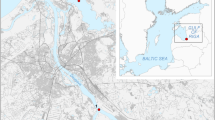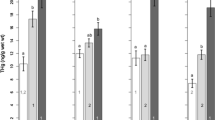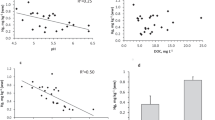Abstract
Young-of-the-year and yearling northern pike (Esox lucius), yearling yellow perch (Perca flavescens) and adult crayfish (Orconectes virilis) were collected in the mercury-contaminated Wabigoon/English/Winnipeg River System, Ontario, and analyzed for total mercury. Analysis of mercury concentrations in these organisms produced consistent geographical trends; i.e. mercury concentrations in biota downstream of Dryden > English River system > Winnipeg River system > control sites. In the Wabigoon River system the bioavailability of mercury increases with distance downstream of the historical point source. Mercury concentrations in the biota studied were highly correlated with mercury concentrations in fish species which are of sport and commercial interest. The locations where young fish obtain their bodyburdens are known typically within 100 m. The biota studied compare favourably with the criteria proposed by Phillips (1980) as prerequisites for biological indicators. The wide distribution of young pike, perch and crayfish in North America, Europe and Asia may enhance their appeal as biomonitors.
Similar content being viewed by others
References
Allan, R. J., Brydges, T., Dodge, D., Hamilton, R. D., Jeffs, D. G., and Shikaze, K. (ed.): 1984, Mercury pollution in the Wabigoon-English River System of Northwestern Ontario and Possible Measures, Published by Government of Canada (Department of Environment) and Government of Ontario (Ministry of the Environment).
ArmstrongF. A. J. and HamiltonA. L.: 1973, ‘Pathways of Mercury in a Polluted Northwestern Ontario Lake’, in P. C.Singer (ed.), Trace Metals and Metal-organic Interaction in Natural Waters. Ann Arbor Science Publishers, Ann Arbor, Mich., pp. 131–155.
ArmstrongF. A. J. and ScottD. P.: 1979, ‘Decrease in Mercury Content of Fishes in Ball Lake, Ontario, since Imposition of Controls on Mercury Discharges’, J. Fish. Res. Board Can. 36, 670–672.
Bishop, J. N. and Neary, B. P.: 1976, ‘Mercury Levels in Fish from Northwestern Ontario, 1970–1975’, Laboratory Services Branch, Ontario Ministry of the Environment, pp. 84.
Butler, P. A., Andren, L., Bonde, G. J., Jernelov, A., and Reish, D. J.: 1971, ‘Monitoring Organisms’, in F.A.O. Fisheries Reports No. 99 Suppl. 1.
Colby, P. J., McNicol, R. E., and Ryder, R. A.: 1979, Synopsis of Biological Data on the Walleye Stizostedion v. vitreum (Mitchell, 1918), Food and Agriculture Organization of the United Nations. Fisheries Synopsis No. 119, p. 139.
Curry, C. and Suns, K.: 1980, ‘A Young Fish Survey of the Wabigoon River-Clay Lake System, 1978’, in Mercury Pollution in the Wabigoon-English River System of Northwestern Ontario and Possible Remedial Measures, 1980, Governments of Canada and Ontario, p. 4.
FagerstromT., AsellB., and JernelovA.: 1974, ‘Model for Accumulation of Methylmercury in Northern Pike’, Esox lucius' Oikos 25, 14–20.
German, M. J.: 1969, Water Pollution Survey of the Wabigoon River, Ontario Water Resources Commission, Report 24P. Available from Chief, Water Resources Assessment, Ontario Ministry of Environment, Thunder Bay, Ontario.
HaugA., MelsomS., and OmangS.: 1974, ‘Estimation of Heavy Metal Pollution in two Norwegian Fiord Areas by Analysis of the Brown Algae’, Ascophyllum nodosum Environ. Pollut. 7, 179–92.
Hamilton, A. L.: 1972, ‘Pond Experiments on the Uptake and Accumulation of Mercury by Selected Fresh Water Organisms’, in Uthe, J. F. (ed.), Mercury in the Aquatic Environment: A Summary of Research carried out by the Freshwater Institute 1970–1971, Fish. Res. Board Can. Manuscript Report Series No. 1167.
Jackson, T. A. and Woychuk, R. N.: 1980, ‘The Biogeochemistry and Distribution of Mercury in the Wabigoon River System’, in T. A. Jackson (ed.), Mercury Pollution in the Wabigoon/English River System of Northwestern Ontario and Possible Remedial Measures: A Progress Report, Published by Government of Canada (Dept. of Environment) and Government of Ontario (Ministry of the Environment), 28 p.
JohnelsA. G., WestermarkT., BergW., PerssonP. I. and SjostrandB.: 1967, ‘Pike (Esox lucius L.) and some Other Aquatic Organisms’ in Sweden as Indicators of Mercury contamination in the Environment’, Oikos 18, 323–333.
Laine, A.: 1989, ‘Ecology of a Northern Pike (Esox lucius) Population in a Small Oligotrophic Lake with Comparisons to Other Northwestern Ontario Populations’, M.Sc.Thesis, Lakehead University, Thunder Bay, Ontario, Canada.
Loescher, B. R. and Neary, B. P.: 1981, ‘The Determination of Mercury in Environmental Samples’, Laboratory Services Branch, Ontario Ministry of the Environment.
MomotW. T., GowingH., and P. D.Jones: 1978, ‘The Dynamics of Crayfish and Their Role in Ecosystems’, The American Midlands Naturalist 99 (1), 10–35.
NorstromR. J., McKinnonA. E. and deFreitasA. S. W., 1976, ‘A bioenergetics-Based Model for Pollutant Accumulation by Fish. Simulation of P.C.B. and Methylmercury residual Levels in Ottawa River Yellow Perch (Perca flavescens)’, J. Fish. Res. Board. Can. 33 (2), 248–267.
Parks, J. W.: 1976, ‘Mercury in Sediments and Waters in the Wabigoon-English River System’, 1970–75. Tech. Rep. Ont. Minist. Environ., p. 28. Available from Chief, Water Resources Assessment, Ontario Ministry of Environment, Thunder Bay, Ontario, Canada.
ParksJ. W.: 1988, ‘Selected Ecosystem Relationships in the Mercury Contaminated Wabigoon-English River System, Canada, and their Underlying Causes’, Water, Air, and Soil Pollution 42, 267–279.
Parks, J. W., Sutton, J. A., and Hollinger, J. D.: 1984, ‘Mercury Contamination of the Wabigoon-English Winnipeg River System, —Causes, Effects and Possible Remedial Measures’, in Allan et al., 1984. Ibid., pp. 1–352.
ParksJ. W. and HamiltonA. L.: 1987, ‘Accelerating Recovery of the Mercury-Contaminated Wabigoon/English River System’, Hydrobiologia 149, 159–188.
ParksJ. W., SuttonJ. A., HollingerJ. D., and RussellD. D.: 1988, ‘Uptake of Mercury by Caged Crayfish’, Applied Organometallic Chemistry 2, 181–184.
ParksJ. W., LutzA. L., SuttonJ. A., and TownsendB. E.: 1989, ‘Water Column Methylmercury Concentrations in the Wabigoon/English River-Lake System: Factors Controlling Concentrations, Speciation and Net Production’, Can. J. Fish. Aquat. Sci. 46, 2184–2202.
Phillips, D. J.H.: 1980, Quantitative Aquatic Biological Indicators: Their Use to Monitor Trace Metal and Organochlorine Pollution, Applied Science Publishers, p. 487.
ScottD. P.: 1974, ‘Mercury Concentration of White Muscle in Relation to Age, Growth, and Condition in Four Species of Fish from Clay Lake, Ontario’, J. Fish. Res. Board Can. 31 (11), 1723–1729.
ScottD. P. and ArmstrongF. A. J.: 1972, ‘Mercury Concentration in Relation to Size in Several Freshwater Fishes from Manitoba and Northwestern Ontario’, J. Fish. Res. Board Can. 29, 1685–1690.
ScottW. B. and CrossmanE. J.: 1973, ‘Freshwater Fishes of Canada’, Bulletin 184, Fish. Res. Board Can., Ottawa.
SheffyT. B.: 1978, ‘Mercury Burdens in Crayfish from the Wisconsin River’, Environ. Pollut. 17 (3), 219–225.
SunsK. and ReesG.: 1978, ‘Organochlorine Contaminant Residues in Young-of-the-Year Spot, Tail Shiners from Lakes Ontario, Erie and St. Clair’, Journal of Great Lakes Research 4 (2), 230–233.
TurnerM.A. and SwickA. L.: 1983, ‘The English-Wabigoon River System: IV, Interaction Between Mercury and Selenium Accumulated from Waterborne and Dietary Sources by Northern Pike (Esox lucius)’, Can. J. Fish. Aquat. Sci. 40, 2241–2250.
Author information
Authors and Affiliations
Additional information
The views expressed are those of the authors and do not necessarily reflect the views of the Ontario Ministry of the Environment. No endorsement should be inferred.
Rights and permissions
About this article
Cite this article
Parks, J.W., Curry, C., Romani, D. et al. Young northern pike, yellow perch and crayfish as bioindicators in a mercury contaminated watercourse. Environ Monit Assess 16, 39–73 (1991). https://doi.org/10.1007/BF00399593
Issue Date:
DOI: https://doi.org/10.1007/BF00399593




